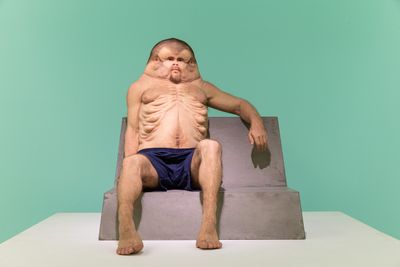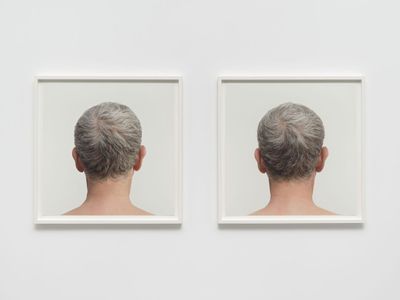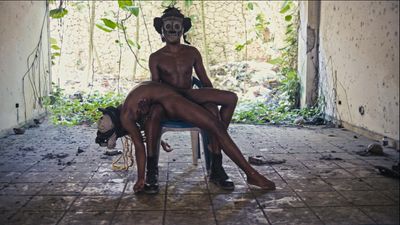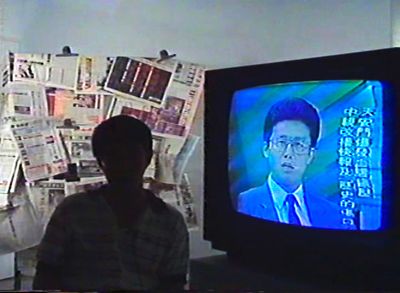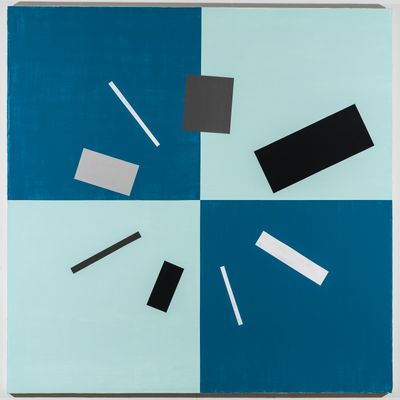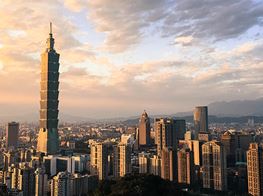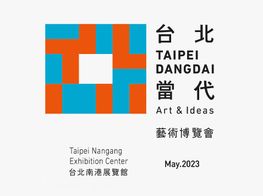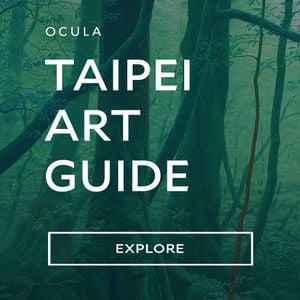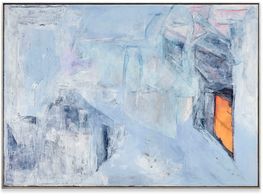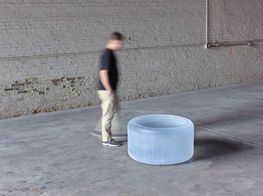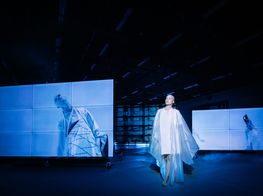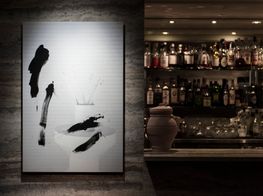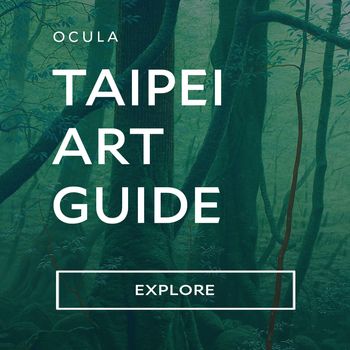Lowdown: Taipei's 5 Best Shows to See

Andro Wekua, Untitled (2014). Fake hair, silicone, wax, polymer plaster, PU foam, steel, glass, synthetic rope, aluminium cast, fabric, motors, electronics, and mechanics. 212.1 x 101.6 x 68.6 cm. Private collection. Exhibition view: Supernatural: Sculptural Visions of the Body, Taipei Fine Arts Museum (18 February–4 June 2023). Courtesy the artist and Taipei Fine Arts Museum.
Spring promises to enliven Taipei with art and visitors returning to the city for its biggest contemporary art fair Taipei Dangdai (12–14 May 2023). Anticipating a busy season, Ocula Magazine shares five must-see exhibitions around the city.
Supernatural: Sculptural Visions of the Body
Taipei Fine Arts Museum, No. 181, Section 3, Zhongshan North Road
18 February–4 June 2023
Expect: uncanny life-size sculptures that model the future of bio-engineered bodies adapted to deteriorating ecosystems.
Supernatural: Sculptural Visions of the Body brings together 33 realistic and hyper-realistic sculptures by 23 artists who contend with a future of hybrid life forms, genetically modified organisms, AI intelligence, and the impact of technology on life itself.
Under sustained natural and man-made environmental pressures, bodies are under pressure to be re-engineered to model machine-like efficiency and transcend the all-too-human. The strange forms that might emerge from this process are explored in sculptural form throughout the exhibition.
Made in consort with the Transport Accident Commission in Victoria, Australia, to highlight the dangers of speeding, Patricia Piccinini's Graham (2016) has bodily features that would allow humans to survive car crashes: a giant head, no neck, a sinking face, and a mutated, enlarged chest lined with two rows of wrinkled breasts. Seated on a block of concrete, the silicone and fibreglass body hints at the physical adaptations technological advances might allow.
Nodding to our instinctual connections to nature and the possibilities of genetic engineering, Sam Jinks' equally realistic silicone figure, Doghead (2008), features a solemn fox head on a pale, nude human body holding one hand over its chest.
Other artists, including Andro Wekua and Isa Genzken, pose a pertinent question: what is distinct about humans? If it is the mysterious substance we call 'soul', then individual identity cannot be replicated using data sets alone, however 'intelligent' the resulting artificial entity.
Wekua's Untitled (2014) illustrates the point with a close-eyed cyborg hanging by the chin from a glass ledge that is suspended from the ceiling inside a pink-carpeted room, while in Genzken's Schauspieler III, 3 (2005), nine mannequins stand in a circle hinting at the many personas a single person embodies.
Roni Horn
Winsing Art Place, No. 6, Alley 10, Lane 180, Sect 6, Minquan East Road
15 April–16 July 2023
Expect: a four-decade-long exploration of identity and androgyny that finds expression in distant Icelandic landscapes.
Roni Horn's inquiries into personhood and place are largely inspired by her first visit to Iceland in 1975 as a young graduate. The local landscape and climate became the subject of her photography, thoroughly explored in the ten-tome photologue 'To Place' (1990–2011), and, subsequently, her sculptural practice.
Both strands of work are notable for exploring gender and self through repetition and doubling, where identical subjects or objects are placed in near-identical settings, yet are visibly changed, reflecting on our contextual understanding of all things.
Horn's series 'Pair Objects' (1980–ongoing) comprises identical sculptures staged in different rooms to suggest perception is shaped by expectation, be it the originality of artwork inside a gallery or identities and preferences deduced from a person's appearance.
The distant expansiveness of Iceland's volcanic landscapes then provides a more objective frame to contend with these realities, as noted in Black Yes (2000), an ebony prism cast in solid glass, given a reflective surface that evokes a body of water from places untouched by industrial waste.
Also on view are the six inkjet prints forming Untitled (Weather) (2010–2011), which capture the rapid transitions of Iceland's temperamental climate, with sunlight illuminating and obscuring different parts of a woman's face, where subtle emotional shifts take place.
White Dickinson (THE MOST INTANGIBLE THING IS THE MOST ADHESIVE (2006), an aluminium pole inscribed with a phrase from American poet Emily Dickinson's correspondences, reflects another of Horn's ongoing concerns: the relationship between language and art, as Dickinson's words become distorted when sighted from any other angle than the classical frontal view.
NEXUS—Video and New Media Art from the Caribbean
Museum of Contemporary Art, Taipei, No. 39 Chang-An West Road
6 May–16 July 2023
Expect: a dive into the impact of globalisation on island ecologies across poignant works by seven video artists who inhabit these realities.
Artists from the Caribbean are featured at MoCA Taipei for the first time, invited by Dutch curator Sasha Dees to investigate the impact of colonialism on the archipelagos and Taiwan, and how such histories have contributed to ecological decay in places long associated with ideas of paradise.
Seven video works by artists from Trinidad and Tobago, Puerto Rico, and Curacao, among other countries, address subjects of transnational labour, migration, political protest, climate change, and sustainable development, offering Taiwanese audiences a mirror to reflect on their own realities.
In the video installation Mes Rêves / My Dreams (2021), Maksaens Denis delves into the violence, oppression, and greed shaping the political landscape of Haiti, seeking to release repressed urges or sentiments of anger, sadness, and frustration through dream loops.
Foreign in a Domestic Sense (2021), a four-channel video by Sofía Gallisá Muriente and Natalia Lassalle-Morillo, features testimonies and imaginings by Puerto Rican migrants in Florida who have escaped political and ecological crisis at home. The artists imagine a future in which movement is borderless and Florida becomes a submerged island.
Chi-Wen Cinema – How Was History Wounded
Chi-Wen Gallery, No. 32, Lane 2, Section 6, Zhongshan North Road
13–27 May 2023
Expect: a screening of ten video works that attest to the power of independent filmmaking and video art to counter news media misinformation.
Titled after a 1989 film by Wang Jun-Jieh and Cheang Shu-Lea, How Was History Wounded is the first of a video exhibition series at Chi-Wen Gallery. In addition to the video by Wang Jun-Jieh and Cheang Shu-Lea, it also includes works by seven other artists, Chang Li-Ren, Yao Jui-Chung, Cheng Yuan, Peng Hung-Chih, Su Hui-Yu, Rui Lanxin, and Yu Cheng-Ta.
Wang and Cheang's montage reflects different portrayals of the 1989 Tiananmen Massacre and the 1988 20 May Demonstrations, when protests supporting farmers' rights ended in bloodshed. The artists juxtapose edited footage from news reports on both sides of the Taiwan Strait with live footage of the events, addressing how news media can be used by governments to reframe political events.
Independent filmmaking is offered as an alternative to popular media; a source that can potentially shed light on propagated narratives that transcend the boundaries of reality but are reported as 'news' in the media.
Daily Pictures
Each Modern, 38 Lane 79 Sec. 2 Xinyi Road
10 May–21 June 2023
Expect: paintings, sculptures, and installations that explore the practice of art as a repetitive act of return that unfolds nuance in an ever-changing and complicated world.
Daily Pictures features work by nine intergenerational artists who have selected art as a means of observation and inquiry into the unpredictability and fluidity of life today.
The exhibition illuminates the often-forgotten perspective of art-making as a daily practice, with works by Cici Wu, Margaret Lee, and Mari Eastman, among others, exemplifying the discoveries that can be made through sustained observation and return.
Curator Alex Jen has selected five artists from Chicago, where he previously lived, who address the American context from different cultural perspectives. Among them is Gaylen Gerber, known for his grey 'Support' and 'Backdrop' paintings that invite other artists to paint above them and his practice of concealing an artwork's context to question its neutrality.
For Daily Pictures, Gerber presents two cuchimilcos figures from the Chancay culture—a sancai horse and rider from the Tang dynasty, and a Gandharan winged atlas—each of which find their cultural contexts obscured to bring into question their present-day meaning.
Artist and 47 Canal art space co-founder Margaret Lee's Outer Forms (2023) re-works packing foam with resin, sandpaper, wax, and steel nails to reflect on the futility of identity and function in sculpture, an idea Lee previously explored in 2010 with Katahdin, a cast and hand-painted Katahdin potato, representing classless and banal objects. —[O]

